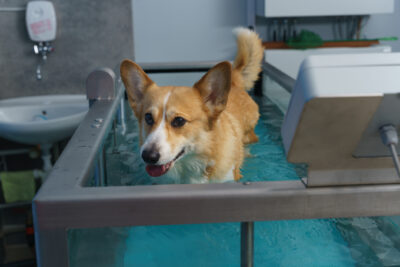When Is a Dog Considered Senior?

Like humans, dogs are more likely to start to show signs of illness when they reach their senior years. Your pup might slow down a little, and become less playful. They even go gray—just like we do!
Knowing when your dog is considered a senior is an important part of pet parenting. It means you can be alert for changes in their behavior or habits that might be signs of illness and you can take steps to keep your dog happy and comfortable well into their golden years.
When Is a Dog a Senior?
There is no set age or date when a dog goes from being an adult to being a senior. In fact, it varies greatly depending on your dog’s breed and size. Many people average the age at which dogs become seniors at around 7 years old, but in reality this can change quite considerably from ages 5 to 12.
Most dogs are puppies until they are around 6 months to 1 year old. Next is the adult life stage. For some dogs, this lasts until 5 or 6 years old, at which point the signs of old age that herald the senior life stage begin. Other dogs will reach 12 years old before they start to age dramatically.
In general, we expect that the ‘senior’ life stage is the last quarter to a third of a dog’s expected life span.
When Is a Small Dog Considered a Senior?
Small dogs—those smaller than about 20 pounds—get to their adult age more quickly than large breeds, often being fully grown by six or eight months of age. After this, though, they age more slowly.
The lifespan of a small-breed dog is, on average, longer than that of a large breed dog—up to about 16 years. Which means that a healthy, small dog might not be considered senior until they are 12 years old.
However, there are some exceptions to the rule. Some small breeds, such as Cavalier King Charles Spaniels, have a shorter lifespan and are considered senior at a younger age—around 8 years old.
When Is a Large Dog Considered a Senior?
Larger breeds of dogs tend to have shorter life spans. This means they reach senior age more quickly than smaller breeds.
Labradors are a good average large breed—with a life expectancy of about 12 years, we would expect them to become senior at 8-9 years of age. Giant breeds such as Leonbergers have an average life expectancy of about 7 years. They are considered seniors when they turn 5 years old.
Elderly, Senior, and Geriatric Dogs: Is There a Difference?

If a dog is senior in the last third to quarter of their lifespan, what do the phrases “elderly” and “geriatric” have to do with it? Well, geriatric is sometimes used interchangeably with the term senior, but for veterinarians this tends to mean the very final stages of an elderly dog’s life.
So, for a Leonberger with a lifespan of seven years, they are senior at five, and geriatric at six and a half. For a Toy Poodle with an average lifespan of over 13 years, the last year and a half could be considered geriatric.
The phrase “elderly” isn’t a term that vets use very often. Elderly could mean a senior or geriatric dog, but usually refers to one that has some signs of age. In other words, it’s not a life stage—it’s just a description.
A dog can be a senior but still be very sprightly and therefore isn’t elderly at all. But a dog that has age-related arthritis, is grey around the muzzle, has some behavioral changes associated with age and is missing a few teeth would likely be described as elderly.
Signs Your Dog Is a Senior

Of course, saying that your dog is senior when they reach the final quarter of their expected life is a little confusing. After all, if you have a rescue you might not know their age, and if you have a mixed breed it might be hard to guess at their life expectancy.
But you may notice signs of aging in your dog as they reach their senior years. Signs that your dog may be approaching the senior stage include:
- Going gray around the muzzle
- Stiffness, especially in the mornings (a sign of arthritis, and one that should not go ignored)
- General slowing down
- Impatience, especially with younger dogs
Lastly, you might notice signs of canine cognitive dysfunction. Signs of cognitive dysfunction in senior dogs include anxiety, interrupted sleeping patterns, unusual evening/night-time activity, and a loss of smell.
Keeping Senior Dogs Comfortable as They Age
As your senior dog ages, they’re prone to many more diseases and conditions. It’s therefore important to keep a close eye on their health and behavior, as well as make some changes to help to keep them more comfortable.
Your veterinarian might recommend “senior bloodwork” as your dog enters their senior years. This is a helpful tool in determining changes in your pet’s health status. Doing bloodwork while they are seemingly healthy can provide a baseline for their health status and help your veterinarian recognize changes more quickly in the future. It can also help with early detection of diseases, such as kidney and liver problems, which may not show signs or symptoms until they are progressed.
Remember that arthritis is a disease, not a normal part of aging. It can be exceedingly painful and impact a pup’s quality of life. If you suspect your dog has arthritis, you should take them to your veterinarian for an assessment, and start pain medications if necessary.
If you’re looking for natural pain-relief remedies, talk to your veterinarian about joint supplements or pet-formulated hemp-oil products. While more research about hemp oil and its benefits for pets is still needed, a study from Colorado State University showed that hemp oil had a positive impact on aging dogs with arthritis.
There are also things you can do at home to help your aging pup. Older and arthritic dogs often struggle with jumping up and down, so consider a ramp or stairs onto the sofa, bed, or into the car. Providing a very comfortable memory foam mattress on the floor is also a good way to keep their joints cared for. Slippery floors may also be a problem for senior dogs—consider adding non-slip matts to wooden floors to help them get traction.
You might also want to adjust your senior dog’s walks to the length and energy level that they are comfortable with. Sometimes, more walks (4-5 times per day) for a shorter period (about 10 minutes or so) are better than one lengthy walk per day. Remember that if your dog is getting shorter or less energetic walks, you should talk to your veterinarian about whether you need to reduce your dog’s calorie intake.
Your senior dog’s brain is important, too. Keeping your dog’s brain fit may help to slow the onset of canine cognitive dysfunction. Try teaching your senior dog a new trick, or remind them of some of the old ones they used to know. If your dog is getting reduced exercise due to arthritis, consider making sure the exercise they do get is more mentally stimulating than usual and try giving your dog joint supplements before walks or play time.
Your dog’s appetite and energy levels should also be monitored for signs of problems—as changes in eating or behavior could signal a health problem.
Dogs can live health and happy lives for several years as seniors, so it’s important to keep your dog comfortable, engaged, and loved well into their golden years.









